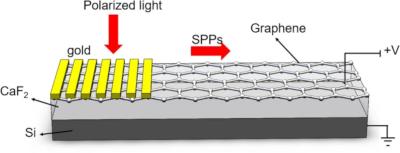Researchers from Ningbo University and Southeast University have designed a hybrid silicon-dielectric-graphene-grating structure, which can modulate the amplitude, wavelength and phase of surface plasmon polaritons (SPPs) simultaneously.
The SPPs are stimulated by the grating and propagating on the graphene, the Fermi level of the graphene is controlled by the voltage applied between silicon substrate and graphene. This structure has potential applications in fields like optical switches, communications and photo-detection.
Multi-parameter control of light is a key functionality to modulate optical signals in photonic integrated circuits for various applications. However, the traditional optical modulators can only control one or two properties of light at the same time.
In their recent study, the team proposed a graphene-based hybrid structure which can modulate the amplitude, wavelength and phase of surface plasmon polaritons simultaneously to overcome these limitations.
The numerical results showed that when the Fermi level of graphene changes from 0.3 to 0.9 eV, the variation of optical transmission, wavelength and phase are 32.7 dB, 428 nm and 306°, respectively. The demonstrated structure signifies an approach for the realization of ultracompact modulation.
